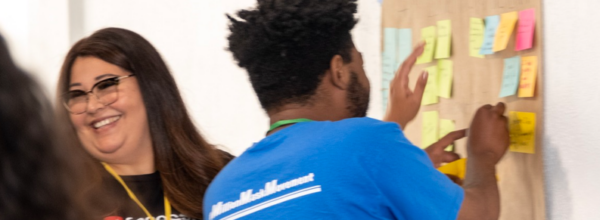Since 2018, the SLO Education Collaborative has worked with young people in person to foster healthy relationships and combat intimate partner violence. But when COVID-19 struck in early 2020 and then dragged on—leaving member organizations slammed with challenges that included staffing shortages, budget cuts, an agency merger, and pandemic response fatigue—the collaborative dug deep to find fresh ways to reach school teens and college students.
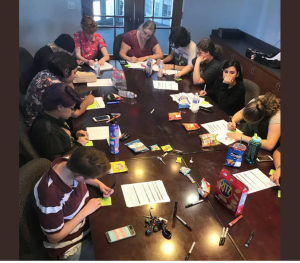
CAPSLO’s Teen Monologues participants working in-person just before COVID required a switch from theatre to podcasts (Credit: NewTimesSLO via Twitter)
To do so, it tapped into relationships with its partners: CAPSLO (Community Action Partnership of San Luis Obispo), GALA Pride & Diversity Center, Lumina Alliance, Restorative Partners, and the California Polytechnic State University organization Cal Poly Safer, which has long worked to host in-person events, train health prevention educators, and provide resources for parents and youth on this sensitive subject.
Consider CAPSLO, a community health and wellness resource center for low-income residents, which includes a Teen Wellness Program housed within its Center for Health and Prevention dedicated to addressing sexual and reproductive health needs. For 18 years, CAPSLO’s teen outreach program produced a performance piece that elevated youth voices while exploring urgent topics in adolescent lives, including sex, drugs, peer pressure, violence, gender identity, and family issues. Once the coronavirus hit, the theater crew was forced to change course. But instead of closing down, as some theatre groups did, it traded live rehearsals for recording sessions, opting to produce a podcast series instead. One episode of “Teen Monologues” is presented in Spanish.
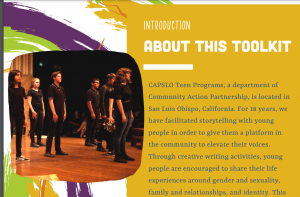 CAPSLO has also developed a free, online storytelling tool kit full of activities for intimate partner prevention educators working with teens. One prompt involves drawing an image of a safe space bubble and including people and objects that are supportive and trustworthy. Another called “Closing the Trauma Jar” involves a visualization exercise designed to help put a lid on upsetting memories or thoughts.
CAPSLO has also developed a free, online storytelling tool kit full of activities for intimate partner prevention educators working with teens. One prompt involves drawing an image of a safe space bubble and including people and objects that are supportive and trustworthy. Another called “Closing the Trauma Jar” involves a visualization exercise designed to help put a lid on upsetting memories or thoughts.
Lumina Alliance, a new group formed in July 2021 with the merger of sexual assault and domestic violence advocacy organizations RISE and Stand Strong, produced an interactive zine designed to educate readers about intimate partner violence (IPV), including information on consent, communication, and boundaries. The 32-page publication was created, written, illustrated, and produced by teens and is available without cost both online (in English and Spanish) and in print form. “Close to Home: Working Toward a Violence Free Community” was distributed at youth-friendly hangouts such as local cafes. The self-published DIY magazine features art and anecdotes from teens with lived experience.
“I chose this image to show that all survivors of sexual assault are strong and just as beautiful as they always have been,” wrote Annika Miltner, 14. “It is important to recognize the growth that we make, even if it is small.” Lumina Alliance also developed a guide for parents and caregivers of pre-teen boys called RedefineSLO, which advises them on how to model and have conversations about healthy relationships.
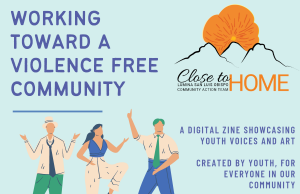 The collaborative seeks to complement work in the field rather than replicate it. “The collaborative is home grown, and there’s beauty to that,” says SLO Education Collaborative team member Jennifer MacMartin, a prevention specialist at Cal Poly Safer, the state university campus’s primary confidential resource for addressing sexual assault, intimate partner violence, domestic violence, stalking, sexual exploitation, and harassment.
The collaborative seeks to complement work in the field rather than replicate it. “The collaborative is home grown, and there’s beauty to that,” says SLO Education Collaborative team member Jennifer MacMartin, a prevention specialist at Cal Poly Safer, the state university campus’s primary confidential resource for addressing sexual assault, intimate partner violence, domestic violence, stalking, sexual exploitation, and harassment.
Amplify Healing Connections, MacMartin said, has provided “meaningful and necessary structure so we’re not just working in our own silos and we don’t reinvent the wheel, but we come together to bolster what each of us is doing and share resources.”
Combating teen dating violence
Teen dating violence is a very real threat, as collaborative members are well aware. Young people ages 12 to 19 years old experience the highest rates of rape and sexual assault. This violence against youth effects all genders, ethnicities, and sexual orientations. Intimate partner violence can take many forms, including sexual abuse, emotional abuse, verbal abuse, financial abuse, online abuse, psychological abuse, spiritual abuse, and physical abuse. Approximately 1 in 5 female high school students report being physically and/or sexually abused by a dating partner, according to Lumina Alliance.
Such trauma can have wide-reaching and long-term impact.. Teen victims of physical dating violence are more likely than their non-abused peers to smoke, use drugs, engage in unhealthy diet behaviors, engage in risky sexual behaviors, or attempt or consider suicide, according to the alliance. And individuals who are controlling of their partners are much more likely to be physically assaultive, which holds equally true for both male and female perpetrators, according to the alliance.
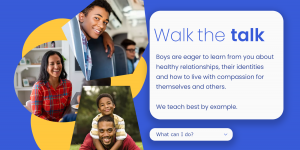
From a guide for the parents and caregivers of pre-teen boys entitled RedefineSLO
Collaborative members have worked together closely to reduce this threat. CAPSLO teen wellness staff have cross-trained Lumina prevention education advocates on intimate partner violence education, effectively doubling the collaborative’s outreach to school-age youth. Lumina Alliance is a county resource center for survivors of sexual assault and IPV. The agency offers no-fee services such as therapy, advocacy support, and a 24/7 crisis and information line.
Youth need a holistic approach to care in this arena, says Emma Fay, a teen wellness coordinator and a collaborative team leader of CAPSLO. The ideal framework, she says, includes focusing on all levels of the issue, including training on effective referrals, youth education and connecting young people who disclose intimate partner or domestic partner violence to a service provider with a warm handoff.
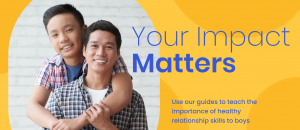
To that end, the SLO collaborative models a three-pronged approach to amplify healing: outreach to teens and parents or caregivers, who need knowledge and support; the community, which provides support and services; and working toward policy change. For example, CAPSLO works with middle and high school administrators to ensure compliance with mandates that include youth curriculum on healthy and unhealthy relationships and how to protect themselves should they need to disclose intimate or domestic partner violence.
Being part of the Amplify Healing Connections cohort has helped the collaborative more formally structure its work, says Fay. “When it comes to collaboration, structure is important,” agrees Armando Ruiz, a prevention educator for Lumina, noting the group always assigns a facilitator and has an agenda available in advance for its monthly meeting.
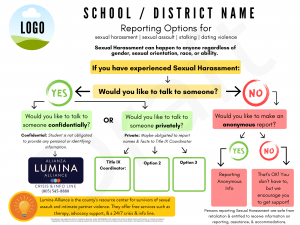
The partnership work also allows for delegation. Lumina Alliance, for example, is leading the charge around policy change. It’s currently working with one school in the area to help it refine its sexual harassment policy in compliance with Title IX, the federal law that prohibits sexual discrimination of any kind at federally funded education institutions. The statute is also intended to protect students from intimate partner violence, sexual assault or stalking on campus and includes mandatory reporting guidelines. All schools and campuses have a duty to prevent, stop, report, and resolve such incidents if they occur on site or involve school staff. The alliance is also busy with an accessible reporting flow chart template for local school students and staff. Down the track, they’d like to see these pilot efforts expanded to other schools.
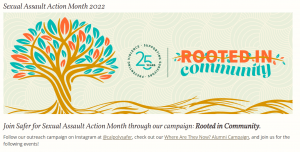
For its part, Cal Poly Safer wants to develop a mentorship program, with students engaging in peer-to-peer education as part of its prevention efforts. While the university is mandated to provide web-based sexual violence prevention training, “clicking through an online module is never as effective as education delivered in community,” says MacMartin. “While students have a baseline to work with and are familiar with terminology, I don’t think we’re going to change behavior or prevent violence from one online exposure to this issue. It takes multiple touchpoints and repeated dialogue.” Cal Poly Safer offers a variety of forums to do just that.
Looking to the future
Still, sexual violence remains a pressing issue. Student survey data gathered by the university and reported in Winter 2020 found 28% of respondents had experienced sexual assault, a third of respondents are regularly psychologically abused, and 18% face stalking behavior. Media accounts of two reported on-campus rapes in October 2021 and a 2019 report on soaring sexual assault crimes on campus suggest that despite years of advocacy and outreach work, the problem remains front and center. More than seventy percent of respondents to a November 2021 news survey about sexual assaults and sexual harassment on campus said the university isn’t doing enough to address this matter.
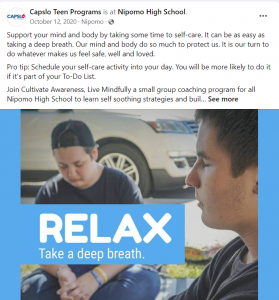 Also last year: A series of LGBTQ+ hate crimes at SLO high schools that have been cause for concern and consultation with local advocates, including GALA.
Also last year: A series of LGBTQ+ hate crimes at SLO high schools that have been cause for concern and consultation with local advocates, including GALA.
Such high-profile incidents are dispiriting, says Fay, but the collaborative’s commitment to change is unwavering. Still, there is recognition of the strain of this intense work, particularly in a pandemic. The collaborative has focused on the team’s health and well-being too. It’s learned to be flexible, knowing that not everybody can participate at every meeting, and that staff turnover is a reality.
Regardless, the collaborative continues its outreach in this area while welcoming new faces into the field. The collaborative also participated in a workshop, led by a Restorative Partners educator, to reflect on how to sustain themselves and connect not just as professionals but as people, too.
In August, the collaborative hosted its first in-person retreat since the pandemic. It was an opportunity to meet team members in real life and to deepen bonds. And it offered a chance to brainstorm about a range of matters, including rebranding and renaming. The collaborative’s existing title doesn’t convey the work the organization does, says Fay, who notes the intention is to rename the organization so that it accentuates the positive work of educating youth around healthy relationships.
Lessons Learned
Accept that partnerships can be difficult
It takes commitment and effort to facilitate, gather, and wrangle different organizations, says CAPSLO’s Fay, who is aware of how easily a partnership can fall apart. “Not many people acknowledge that,” she says. “Partnerships are so essential to expanding outreach. That said, there’s also the hard work of dealing with differences and disagreements and sorting through all of that. It’s worthwhile. It’s also challenging.”
Adjust as needed
The collaborative realized during the pandemic that it made sense to narrow its focus, given the pressure on resources and ramped-up demands on organizations. It opted to reconsider goals and delegate responsibilities.
Seek buy-in on multiple levels
Partners at the SLO Education Collaborative in San Luis Obispo learned quickly that students are hungry for information and support around healthy relationships, sex education, and intimate partner and domestic violence. They need to know where their safe people are—often that’s not their parents or peers, but a trusted third-party support person, such as a health education provider in the community, who can assist them during a crisis,
Partners at the collaborative learned quickly that students are hungry for information and support around healthy relationships, sex education, and intimate partner and domestic violence. They need to know where their safe people are—often that’s not their parents or peers, but a trusted third-party support person, such as a health education provider in the community, who can assist them during a crisis, notes collaborative team member MacMartin of Cal Poly Safer.
Factor in finances
Collaboration between different agencies takes time, money and resources often outside of the scope of members’ work roles and responsibilities. Coordinating meetings, following up on goals, offering training, sharing data, hosting events: This is all work, typically beyond members’ existing job descriptions. Consider including partnership work as its own line item and factor it in accordingly when budgeting time and applying for funding. Tracking hours and associated costs adds legitimacy to such collaborations. Fay sings the praises of consultants with the Nonprofit Finance Fund for helping the collaborative make this mental shift.
Find creative ways to engage youth
Storytelling, podcasting, zine making, performing, peer counseling: Look for diverse, participatory ways to reach teens where they’re at, whether that’s in the community, at school, or on campus.
Moving upstream doesn’t happen overnight
By its nature, policy work can be slow and filled with pitfalls. There are multiple stakeholders to reach, existing policy language to discuss, and decision-makers to engage. Start small: at one school site, for example. Test a pilot policy and work through any obstacles before rolling out a prototype in a bigger way, whether that’s at the school, district, community, city, county, state, or federal level.
Have the courage to hit the pause button
Sometimes it’s important to take a minute. The collaborative paused in August to reflect and begin discussions around future steps. Everything from its mission statement and goals to a new name and location (whether that’s a physical or virtual home) was discussed as the collaborative geared up for the next phase of its work.
_____________________________________________________________________________
Amplify Healing Connections seeks to strengthen interventions designed to prevent domestic violence and promote health and well-being for adolescent youth and their adult allies. Launched in March 2021, the 22-month program, with funding from the Blue Shield of California Foundation, is a collaboration with six California-based, multi-sector partnerships, each involving at least one community-based organization and one health care provider serving youth 12-18 years old. Youth-service organizations play a pivotal role in promoting healthy communication and providing a strong, nourishing environment for young people and their caregivers. Coordinated efforts across community organizations can amplify positive childhood experiences (PCEs) and help prevent, reduce, and even reverse the impact of early adversity.
Stories in this series:
- The Pandemic Led this Central Coast Alliance to Focus on Teens in Crisis
- 10 Ways to Create Effective Community Partnerships
- Amplify Healing Partnership Hosts “Courageous Conversations” Conference for Teens
- “Give the Kids a Voice”: Working on Resilience with Kids and Teens at Risk
- Santa Cruz Coalition on Healthy Relationships Combats Stigma Against Teens of Color With Youth-Led Fun
Find this useful or interesting? We’re constantly sharing stuff like this. Sign up to receive our newsletter to stay in the loop.


